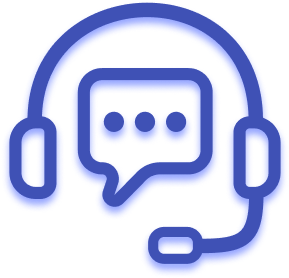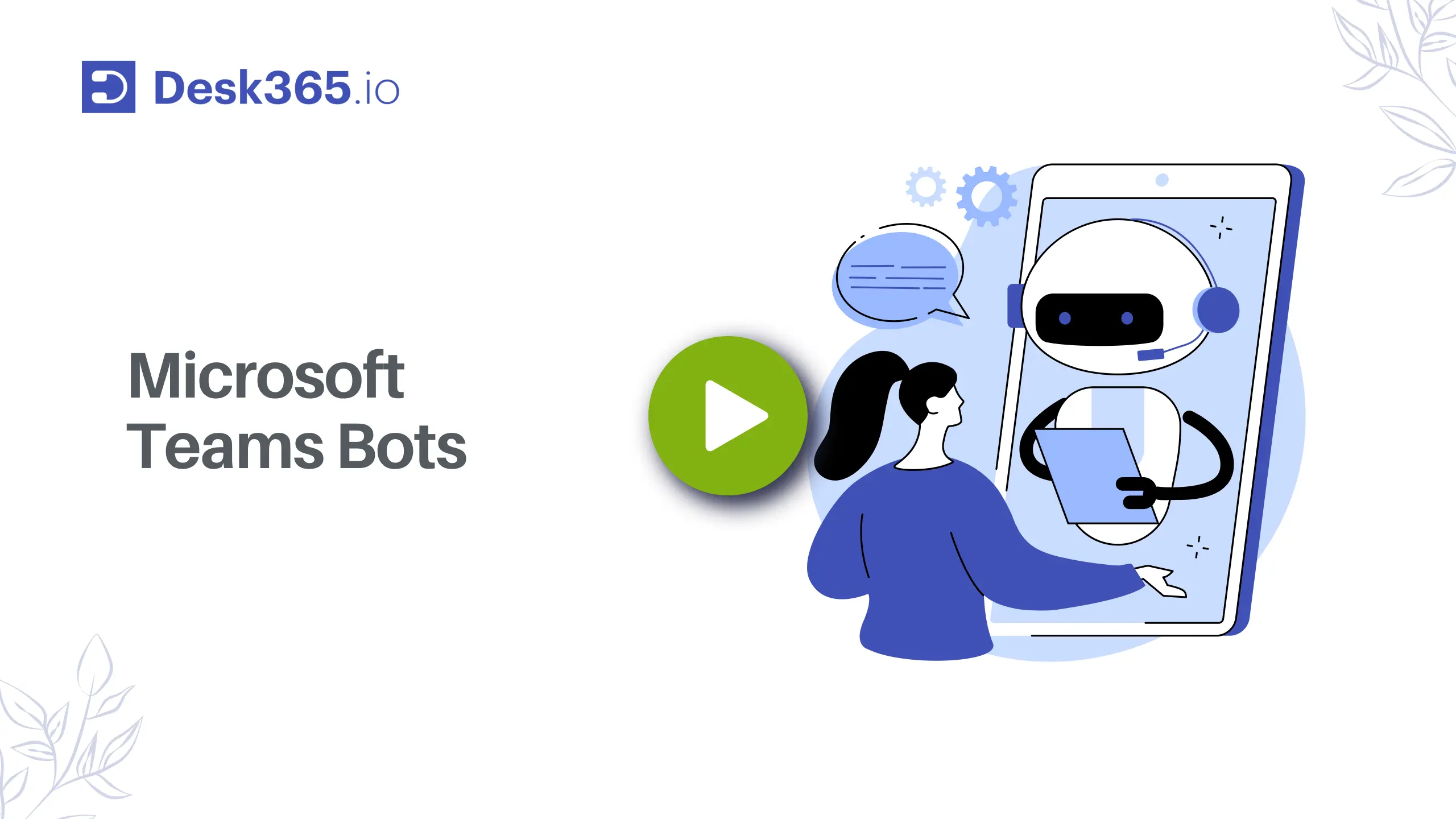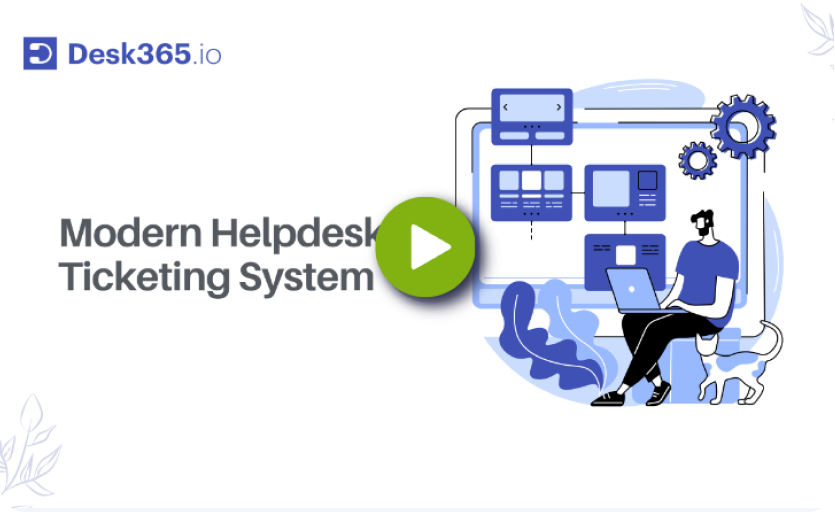Efficiency is critical in IT customer support. With a constant flow of technical queries, ranging from system errors to connectivity issues, support agents need to be equipped with the right tools to respond swiftly and accurately. IT ticket templates can significantly ease this process, helping agents avoid the repetitive task of manually drafting responses for common issues. Instead, they can rely on well-structured IT ticket templates, which reduce response times, streamline workflows, and ensure a consistent and professional customer experience.
Pre-defined IT ticket templates, canned responses, and automated actions are essential features in any IT helpdesk software. They not only enable agents to respond quickly but can also trigger automatic solutions through automation rules. However, it’s important to remember that while templates offer speed, responses should still be personalized and tailored to the specific needs of the customer. A generic IT support ticket response can come across as impersonal, so adding personalized touches ensures that productivity and customer satisfaction both improve.
In this blog post, we’ll explore the top IT ticket templates, best practices for using them effectively, and how Desk365 can help you streamline your IT ticketing process for faster, more efficient issue resolution. Let’s begin with what IT helpdesk response templates are.
What are IT helpdesk response templates?
IT helpdesk response templates are pre-configured email replies designed to help support agents quickly address common technical issues or queries. These templates can be customized with personalized information such as the customer’s name, ticket ID, or specific problem details. By utilizing these templates, IT support teams can save valuable time, allowing them to focus on resolving more complex or critical issues. Additionally, these templates help improve first response time (FRT) while ensuring that every communication maintains a personalized and professional touch with the customer.
Helpdesk software like Desk365 helps you create canned responses, insert placeholders, and use them in your ticket replies.
Benefits of using IT ticket templates
1. Improves first response time (FRT)
When customers raise IT issues—whether it’s a system failure, network downtime, or software malfunction, they expect immediate attention. IT ticket templates allow support agents to respond quickly with pre-defined answers to common queries. This not only enhances the customer experience but also significantly improves first response time (FRT), a critical metric in IT support. Faster initial responses can set the tone for the entire support process, ensuring customers feel heard and valued right from the start.
Recommended Reading: 12 Helpdesk Metrics to Improve Customer Support
2. Boosts support agent efficiency
IT support ticket templates do more than just speed up customer responses; they also optimize the workflow for support agents. Tasks like password resets, troubleshooting common connectivity issues, or explaining basic system processes can be handled in seconds. This allows agents to prioritize more complex and critical issues that require in-depth analysis and troubleshooting. By reducing the manual effort on routine tasks, templates free up agents to focus on higher-value activities, enhancing overall agent productivity.
3. Reduces errors and ensures consistency
Manually crafting responses for every query can lead to small but noticeable mistakes, such as typos, missing signatures, or inconsistent formatting. IT ticket templates eliminate the risk of these common errors by providing a consistent, professional framework for responses. This not only reduces grammatical mistakes but also ensures that all communications reflect the company’s branding and tone. With templates in place, every response aligns with your brand guidelines and service quality standards.
4. Enables customization and personalization
While templates provide a foundation for efficient responses, they also allow room for customization. IT ticket templates can be easily adjusted to include personalized details like the customer’s name, ticket number, or issue-specific information. This maintains a personal touch, ensuring that responses don’t come across as generic or automated. Customization ensures that customers still feel a human connection, even when agents are using pre-defined templates.
Recommended Reading: 8 Easy Ways to Deliver Personalized Customer Service
5. Supports scalability in IT operations
As IT departments grow or deal with increasing ticket volumes, scalability becomes a key concern. Templates provide a scalable solution to managing high volumes of tickets without sacrificing quality. Whether handling routine maintenance queries or technical issues across multiple departments, IT ticket templates enable support teams to maintain service levels as demand increases. This ensures a smooth, consistent support experience, even as the number of requests grows.
6. Improves knowledge sharing and collaboration
By using standardized IT ticket templates, teams can more easily share knowledge and collaborate on resolving issues. If a certain type of technical problem keeps recurring, templates can be updated and shared across the entire team, ensuring everyone is equipped with the latest, most effective solutions. This collaborative approach can improve problem resolution times and reduce the learning curve for new agents, ensuring everyone is aligned on best practices.
Best practices for using IT ticketing templates in a ticketing system
Whether your organization is just adopting an IT helpdesk ticketing system or you’re already managing a large volume of technical support queries, following best practices can help you optimize your use of IT ticket templates. Below are some key strategies to ensure you’re getting the most out of your helpdesk system:
1. Leverage AI for intelligent responses and routing
Artificial Intelligence (AI) has transformed how IT ticketing systems operate. By incorporating AI, your system can automatically suggest relevant responses to common IT issues based on ticket content, saving agents time and reducing response delays. AI can also help route tickets to the most appropriate support agent based on the nature of the issue or the agent’s expertise, ensuring that tickets are handled by the right person without manual intervention. Additionally, AI-driven tools can correct grammar, suggest more effective ways to phrase responses, and even translate messages into different languages, making your support team more efficient and adaptable in a global context.
2. Set up automated responses for ticket updates
Automation is key to keeping your customers informed without overwhelming your agents. Implement automatic responses for key stages in the support process, such as sending confirmation when a ticket is received, providing updates when an agent is assigned or actively working on the issue, and notifying the customer when the problem is resolved. These automated updates not only reassure customers that their issues are being handled but also reduce unnecessary follow-up inquiries, allowing your agents to focus on problem resolution rather than status updates.
3. Use ticket templates to meet SLAs and employee expectations
Service Level Agreements (SLAs) are vital in maintaining high standards for IT support. IT ticket templates can help your team stay on top of SLAs by ensuring that common issues are addressed quickly and effectively. Pre-written templates can reduce response times for frequent technical issues, helping agents meet their SLA requirements. Additionally, well-crafted templates set clear expectations for both employees and customers about the support process, improving overall satisfaction on both sides.
Recommended Reading: The Ultimate Guide to Service Level Agreements (SLAs)
4. Align templates with your brand for a personalized experience
It’s important to ensure that your IT ticket templates are aligned with your brand’s tone and style. A response should not feel robotic or overly generic. While templates speed up communication, they should also reflect your company’s values and customer service ethos. Personalization can make a big difference here—adding the customer’s name, referencing specific details about their query, and using a warm and helpful tone can transform a template from a generic message into a tailored response that makes the customer feel valued and understood.
5. Build a comprehensive knowledge base
Over time, your IT ticket templates can form the foundation for a robust knowledge base. By documenting solutions to common IT problems, you can create an easily accessible resource for both customers and support agents. This not only empowers customers to solve simple issues on their own but also allows support agents to quickly access standardized solutions for recurring technical problems. A well-maintained knowledge base can dramatically reduce the number of incoming tickets, improve resolution times, and enhance self-service options.
6. Regularly update and refine templates
IT environments are dynamic, with new technologies, software updates, and security protocols frequently emerging. Ensure that your ticket templates are regularly reviewed and updated to reflect the latest information. Outdated templates can lead to confusion or incorrect instructions, which could frustrate customers and lead to unnecessary escalations. By keeping your templates current, you ensure that your team is always providing accurate and timely support.
7. Track template performance
To get the most out of your IT ticket templates, track their performance by analyzing key metrics like response times, customer satisfaction scores, and resolution rates. If certain templates are leading to faster resolutions or higher customer satisfaction, you can replicate their success across other areas. Conversely, if some templates are underperforming, they can be adjusted or replaced. Regular performance analysis helps you optimize the effectiveness of your templates.
8. Incorporate multilingual support
If your IT support services cater to a diverse or international audience, make sure your ticket templates support multiple languages. This ensures that language barriers don’t hinder communication and that all customers receive the same high level of support. AI tools can assist with automatic translations, but it’s important to review these translations to ensure accuracy and maintain the quality of communication.
20 best IT ticket template examples to deliver efficient support
IT support teams often deal with a wide variety of technical issues and customer requests. Here are 20 of the most common situations your IT support agents might encounter, along with detailed explanations and sample templates for each.
1. Issue acknowledgment template
Purpose: To confirm that a customer’s issue has been received and is being looked into.
Subject: We’ve Received Your Request – [Ticket ID]Dear [Customer Name],
Thank you for reaching out! We’ve received your ticket ([Ticket ID]) and our team is currently reviewing your request. We’ll get back to you as soon as possible with further updates. If you have any additional information to provide, feel free to reply to this email.
Best regards,
[Your Name]
IT Support Team
2. Follow-up template
Purpose: To inform the customer about the assigned agent, gather additional information if needed, or provide other follow-up details.
Subject: Follow-up on Your IT Request – [Ticket ID]
Hi [Customer Name],
I wanted to update you on your ticket ([Ticket ID]). Our support agent, [Agent Name], has been assigned to your case and is currently reviewing the details. To help us resolve your issue more quickly, could you please provide the following additional information?
[Specific Information Needed]
[Another Example of Required Details]
If there’s anything else you’d like to add or clarify, feel free to reply to this email. We appreciate your cooperation and are working to resolve the issue as soon as possible.
Best regards,
[Your Name]
IT Support Team
3. Status update template
Purpose: To keep the customer informed about the progress of their ticket.
Subject: Update on Your IT Issue – [Ticket ID]
Hi [Customer Name],
We wanted to provide you with a quick update on your ticket ([Ticket ID]). Our team is actively working on resolving your issue, and we expect to have a solution soon.
Thank you for your patience!
Best regards,
[Your Name]
IT Support Team
4. Sharing a knowledge base link template
Purpose: To provide a link to a knowledge base article that addresses the customer’s issue.
Subject: Solution for Your Issue – [Ticket ID]
Hi [Customer Name],
It seems that the issue you’re experiencing is a common one. You can find a detailed solution in this knowledge base article: [Insert Link].
If you need further assistance or the article doesn’t resolve the issue, don’t hesitate to reply to this email.
Best regards,
[Your Name]
IT Support Team
Recommended Reading: 12 Best Canned Response Templates for Customer Support Emails
5. Issue escalation notice template
Purpose: To inform the customer that their ticket has been escalated to a higher-level support agent.
Subject: Your Issue Has Been Escalated – [Ticket ID]
Hi [Customer Name],
We wanted to let you know that your ticket ([Ticket ID]) has been escalated to our senior IT team for further investigation. They will be reviewing your case and will provide an update soon.
Thank you for your understanding!
Best regards,
[Your Name]
IT Support Team
6. Issue resolved template
Purpose: To notify the customer that their issue has been resolved.
Subject: Your Issue Has Been Resolved – [Ticket ID]
Hi [Customer Name],
We’re happy to inform you that your issue with [brief issue description] has been resolved. If you experience any further issues, feel free to contact us again.
Thank you for your patience!
Best regards,
[Your Name]
IT Support Team
7. Feature request reply template
Purpose: To acknowledge a feature request from the customer and provide an update on its status.
Subject: Feature Request Acknowledgement – [Ticket ID]
Hi [Customer Name],
Thank you for your feature request regarding [Feature Description]. We’ve logged your suggestion, and it will be reviewed by our development team. While we can’t guarantee immediate implementation, we value your feedback and will keep you updated on any changes.
Best regards,
[Your Name]
IT Support Team
8. Website downtime notification template
Purpose: To notify customers of scheduled or unexpected website downtime.
Subject: Scheduled Website Downtime – [Date & Time]
Hi [Customer Name],
Please note that our website will be down for scheduled maintenance from [Start Time] to [End Time] on [Date]. During this time, you will be unable to access our services. Please plan your day accordingly.
We apologize for any inconvenience this may cause and appreciate your understanding.
Best regards,
[Your Name]
IT Support Team
9. Error apology template
Purpose: To apologize for an error made by the system or the support team.
Subject: Apology for Error – [Ticket ID]
Hi [Customer Name],
We sincerely apologize for the inconvenience caused by the [error description]. Our team is working to resolve the issue, and we will update you as soon as we have a solution.
Thank you for your patience!
Best regards,
[Your Name]
IT Support Team
Recommended Reading: How to Write an Apology Mail to Client: Tips & Templates
10. Unexpected outages template
Purpose: To inform customers about unexpected outages or disruptions.
Subject: Unexpected Service Outage – [Ticket ID]
Hi [Customer Name],
We are currently experiencing an unexpected outage affecting [service/system]. Our team is working to resolve the issue as quickly as possible. We will keep you informed of any updates.
Thank you for your understanding.
Best regards,
[Your Name]
IT Support Team
11. Equipment release form response template
Purpose: To acknowledge receipt of a request for releasing equipment.
Subject: Equipment Release Request – [Ticket ID]
Hi [Customer Name],
We’ve received your request for the release of [equipment]. Our team is processing it, and you’ll be notified once it’s ready for pickup.
Best regards,
[Your Name]
IT Support Team
12. Equipment return form response template
Purpose: To confirm the return of equipment.
Subject: Confirmation of Equipment Return – [Ticket ID]
Hi [Customer Name],
We’re writing to confirm that we’ve successfully received the return of the [equipment]. Thank you for returning the item as requested. If you need any further assistance or have any questions regarding this return or future requests, feel free to contact us.
Best regards,
[Your Name]
IT Support Team
13. Application installation response template
Purpose: To confirm the successful installation of requested software.
Subject: Application Installation Complete – [Ticket ID]
Hi [Customer Name],
The requested application, [Application Name], has been successfully installed on your device. If you encounter any issues, please contact us for support.
Best regards,
[Your Name]
IT Support Team
14. Malware-related response template
Purpose: To guide the customer through resolving a malware issue.
Subject: Malware Detected – [Ticket ID]
Hi [Customer Name],
Our system has detected malware on your device. Please follow the steps in this guide to remove it: [Link]. If you need further assistance, don’t hesitate to reach out.
Best regards,
[Your Name]
IT Support Team
15. Hardware/software change response template
Purpose: To confirm that requested hardware or software changes have been made.
Subject: Hardware/Software Changes Completed – [Ticket ID]
Hi [Customer Name],
We’ve completed the requested changes to your hardware/software. If you encounter any issues, please contact us for support.
Best regards,
[Your Name]
IT Support Team
16. Password reset request response template
Purpose: To assist the customer with resetting their password.
Subject: Password Reset Assistance – [Ticket ID]
Hi [Customer Name],
We’ve processed your password reset request. Please use the following link to reset your password: [Password Reset Link]. If you encounter any issues, let us know.
Best regards,
[Your Name]
IT Support Team
17. Access request response template
Purpose: To confirm access requests such as VPN or system access.
Subject: Access Request Approved – [Ticket ID]
Hi [Customer Name],
Your request for access to [System/Service] has been approved. You can now log in using your credentials.
Best regards,
[Your Name]
IT Support Team
18. Customer feedback request template
Purpose: To request feedback after resolving an issue.
Subject: We Value Your Feedback – [Ticket ID]
Hi [Customer Name],
We’ve resolved your issue and would appreciate your feedback on your experience with our support team. Please take a moment to complete this short survey: [Feedback Link].
Thank you for helping us improve!
Best regards,
[Your Name]
IT Support Team
Recommended Reading: 11 Email Templates for Writing the Perfect Thank You Note for Customers
19. Subscription cancel request email template
Purpose: To confirm the cancellation of a subscription.
Subject: Subscription Cancellation Confirmation – [Ticket ID]
Hi [Customer Name],
We’ve successfully processed your request to cancel your subscription. Your access will remain active until [End Date]. If you have any questions, feel free to contact us.
Best regards,
[Your Name]
IT Support Team
20. Bug report response template
Purpose: To acknowledge receipt of a bug report, request additional details if necessary, and inform the customer that the issue is being investigated.
Subject: Bug Report Acknowledgement – [Ticket ID]
Hi [Customer Name],
Thank you for bringing this issue to our attention. We’ve received your bug report regarding [brief description of the bug] and our team is currently investigating it.
If possible, could you provide any additional details such as screenshots, steps to reproduce the bug, or any error messages you encountered? This will help us resolve the issue more efficiently.
We’ll keep you updated on our progress and let you know once a solution is in place. In the meantime, feel free to reach out if you have any further questions.
Best regards,
[Your Name]
IT Support Team
Recommended Reading: Writing Effective Customer Service Emails: Tips & Templates
Ticket templates offer a significant advantage for customer service teams, helping them save valuable hours of work. By setting up well-structured response templates, your support agents can reply to common queries quickly and consistently. This not only speeds up response times but also allows agents to focus on more complex issues that require their attention.
However, simply implementing ticket templates isn’t enough; it’s important to train your IT team on best practices for using them effectively. Personalization is key — even with templates, responses should feel tailored to each customer’s specific needs. Additionally, regularly reviewing and updating your templates is crucial.
At Desk365, we offer a range of features that make managing ticket templates easy and efficient. Our canned responses allow your team to send pre-written replies in just a few clicks, saving time and ensuring consistency across support channels. Our Draft with AI feature helps agents craft and redraft responses, correct grammar, and even translate messages into different languages. These tools streamline the support process and improve communication quality.
To experience the power of these features firsthand, we encourage you to start a 21-day free trial of Desk365 today. Discover how our tools can enhance your support team’s efficiency and improve your customer service outcomes.
Frequently asked questions
IT ticket templates are pre-written responses that support agents can use to address common technical issues quickly and consistently.
Templates minimize repetitive typing, allowing agents to focus on more complex tasks. They also ensure a consistent approach to common issues, improving efficiency.
Yes, templates can be personalized by including customer details such as their name, ticket number, or specific issue to maintain a personal touch.
An IT ticketing helpdesk system is a tool used by support teams to track, manage, and resolve customer issues and service requests. It helps organize and prioritize incoming tickets, ensuring efficient resolution of technical problems.
Yes, Desk365 offers a 21-day free trial, allowing you to explore its features, including IT ticket templates, and see how it can improve your support process.









